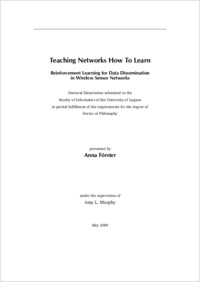Teaching networks how to learn : reinforcement learning for data dissemination in wireless sensor networks
- Förster, Anna
- Murphy, Amy L. (Degree supervisor)
-
14.05.2009
194 p
Thèse de doctorat: Università della Svizzera italiana, 2009
Wireless sensor networks
WSN
Reinforcement learning
Machine learning
Q-learning
Routing
Clustering
Optimization
Energy-efficiency
Failure recovery
Multicast
Role-free
Non-uniform
Data dissemination
Optimal clustering
English
Wireless sensor networks (WSNs) are a fast developing research area with many new exciting applications arising, ranging from micro climate and environmental monitoring through health and structural monitoring to interplanetary communications. At the same time researchers have invested a lot of time and effort into developing high performance energy efficient and reliable communication protocols to meet the growing challenges of WSN applications and deployments. However, some major problems still remain: for example programming, planning and deploying sensor networks, energy efficient communication, and dependability under harsh environmental conditions. Routing and clustering for wireless sensor networks play a significant role for reliable and energy efficient data dissemination. Although these research areas have attracted a lot of interest lately, there is still no general holistic approach that is able to meet the requirements and challenges of many different applications and network scenarios, like various network sizes and topologies, multiple mobile data sinks, or node failures. The current state-of-the-art is rich in specialized routing and clustering protocols, which concentrate on one or a few of the above problems, but perform poorly under slightly different network conditions. The main goal of this thesis is to demonstrate that machine learning is a practical approach to a range of complex distributed problems in WSNs. Showing this will open up new paths for development at all levels of the communication stack. To achieve our goal we contribute a robust, energy-efficient, and flexible data dissemination framework consisting of a routing protocol called \froms and a clustering protocol called Clique. Both protocols are based on Q-Learning, a reinforcement learning technique, and exhibit vital properties such as robustness against mobility, node and link failures, fast recovery after failures, very low control overhead and a wide variety of supported network scenarios and applications. Both protocols are fully distributed and have minimal communication overhead. Additionally, \cliq gives a distributed solution to the recently emerged novel paradigm of non-uniform data dissemination, where the size of the clusters in a network grows with increasing distance from the data sinks. We evaluate the protocols analytically and experimentally under a realistic simulation environment and on real hardware. Thus, we show not only that machine learning is applicable to real-world wireless sensor networks, but that it also achieves significantly better performance in terms of energy spent, network lifetime, load spreading, and delivery rate under various network conditions, when compared to other state-of-the-art routing and clustering approaches. This thesis is one of the rare attempts to compare two routing protocols in terms of communication overhead and delivery rate on real hardware. We believe that this thesis successfully proves that machine learning is a feasible approach for solving various hard problems in wireless sensor networks, paving the way to further applications, protocols and optimizations, which will inherently improve the performance of wireless sensor networks.
- Language
-
- English
- Classification
- Computer science and technology
- License
-
License undefined
- Identifiers
-
- RERO DOC 11976
- URN urn:nbn:ch:rero-006-108124
- ARK ark:/12658/srd1318126
- Persistent URL
- https://n2t.net/ark:/12658/srd1318126
Statistics
Document views: 347
File downloads:
- Texte intégral: 221
